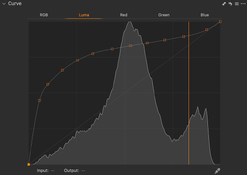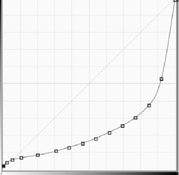Very interesting - plausible, too, but it must be magic to see it happen. Exploring these Japanese tissue papers is something I'd like to do one day (I sound like a stuck record saying that, hah!)
Is it possible that you're using a fairly high UV blocking ink definition, causing issues with shadow separation while maintaining tone in the highlights? I was playing with some curves earlier today and settled on the following for Van Dyke Brown when making some negatives for
@Cor:
View attachment 412099
Note how there's a similar inverse-S shaped curve, but it's a bit steeper in the midtone region. In my experience, having a very flat midtone region can produce/exacerbate problems with posterization.
In a digital negative, all you need is enough density to produce paper white at the exposure that gives dmax for the process. You can make negatives with higher density, but it tends to result in the kind of relatively extreme curves you've shown above.
You could use a scanner or a digital camera (or even the camera on your phone) as an alternative. It may not be quite as good as a proper densitometer, but it almost certainly beats a visual adjustment process.





